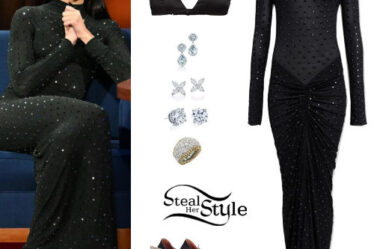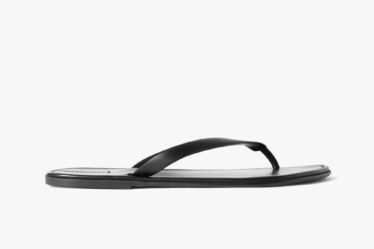
It’s been a minute since I’ve shared strategies about how to save money on clothes. But given the economic climate — inflation, lackluster stock market — the time feels right to revisit the topic that made Budget Fashionista famous. Let’s talk about strategies that’ll save you money.
These aren’t exclusively shopping strategies involving coupons, sales, and the like. The list is broader than that, because your cumulative spend on clothes isn’t solely a function of how you shop. Other factors, like how you care for your clothes and what you do when you’re bored, are also influential.
When you buy via links on this page, I may earn an affiliate commission. Learn more.
Ready to dive in? Here are 24 easy ways to save money on clothes.
1. Shop used
Some of you will be like, ugh, yuck. I know shopping used is an acquired taste — you either love it or hate it. If you hate it, no worries. I’ll just drop in this photo below of a Vince Camuto dress, new with tags, available on Thredup for $31 🙂.
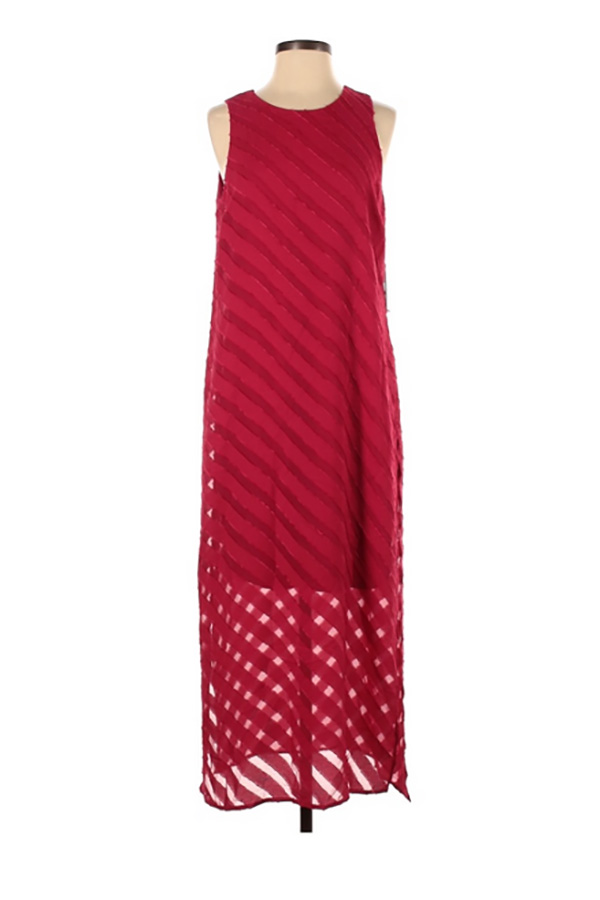
As for where to shop used, drop into your local thrift stores when you have some time. Or try these online shops and apps:
2. Shop out of season
Shopping off-season is an age-old budget fashion hack. It applies today more than ever, thanks to fast fashion shops that churn through trendy pieces. Keep these timing guidelines on your radar:
- Shop coats and boots in the spring and summer.
- Shop jeans in the summer.
- Shop swimwear in the middle-to-end of summer — unless you live in California, Florida, or Hawaii. In those states, look for swimsuits in the dead of winter.
- Shop dresses, skirts, and shorts starting in the fall.
- Look for fall transition wear, like scarves, as winter is winding down.
3. Sell clothes you don’t wear
The dead weight in your closet makes it harder to find the pieces you want to wear. Sell off the dead weight. You’ll generate a few bucks but you’ll also streamline your wardrobe. As noted below, a clean closet contributes to lower spending.
You can sell your clothes on Poshmark, Mercari, or Facebook Marketplace if you prefer the hands-on approach. I prefer Thredup because it’s easier.
4. Keep an inventory
Have you ever purchased an adorable black top only to realize you already have an adorable black top? That’s why you need an inventory of your clothes. And making said inventory is far easier when your closet is organized and clean.
There are various apps that help you manage your garments, such as:
- Stylebook ($3.99)
- Pureple Outfit Planner
- My Wardrobe Outfit Planner
- Peeknest
- WearTracker Clothing Tracker
- Outfit Tracker
One advantage of using an app is that you can track how often you wear each piece. That data will quickly tell you which pieces are candidates for Thredup.
You can also rely on paper or your memory to inventory your wardrobe. I use my memory. The only time this fails me is when the seasons change and I forget to take the box of sweaters down from the top shelf in my closet.
5. Read the tag before you buy
These three words on a garment tag should be a dealbreaker: Dry Clean Only. There are two problems with clothes that must be dry cleaned. One, dry cleaning is expensive. And two, you might put off the dry-cleaning errand indefinitely — at least that’s what I do. Once that nice garment is dirty, it sits in my closet gathering dust. That raises the garment’s cost-per-wear, which is wasteful.
6. Skip the wrinkly fabrics
Unless you love to iron, say no to fabrics that wrinkle easily. If you could wear a cute top that has no wrinkles or a cute top that needs an iron, what’s your choice? The one that’s already wrinkle-free, of course. You’ll get less use from the wrinkly garment, which means it has less value.
6. Wash with care
Washing and drying is tough on your clothes. Whenever possible, wash in cold on the delicate cycle and hang or lay flat to dry. Your laundry room might get cluttered in the process, but your clothes will last longer.
7. Borrow or rent for special occasions
An outfit for a special occasion can easily break your entire clothing budget for the year. Try renting or borrowing formal gowns. Check first with friends who are your size. If that doesn’t produce any good options, try Rent the Runway or JJ’s House.
8. Buy discount gift cards
If you know where you want to shop, look for a discount gift card for that store. You’ll find the biggest discounts on brand-name stores like Gap, Old Navy, or American Eagle. JC Penney and Macy’s are good options also. Discounts are much leaner on the more popular stores like Target and Amazon.
Places to shop discount gift cards are:
9. Layer your rebates
Earn rebates from your credit card, cashback apps like Rakuten and Fetch, and store loyalty programs. Layer them whenever possible.
Then, collect your rebates in an account that’s earmarked for future clothing spend.
10. Check for coupons with a browser extension
The hunt for coupon codes on coupon websites like retailmenot be more painful than sticking a pencil in your eye. In recent years, I’ve largely ditched the practice in favor of browser extensions that find coupons for you. The two I use are Coupert and Rakuten.
As you shop, these browser extensions notify you when coupons are available. In the shopping cart, you can tap the notification and the application will test a series of coupons to find you the best one.
The drawback is that the notifications can be annoying. Even so, having the browser extension beats manually typing in 25 different coupon codes only to find that none of them work.
11. Pay off your credit card monthly
Charging clothes to a credit card to earn a rebate is counterproductive if you incur interest charges on that purchase. Here are the numbers. Your credit card probably charges you at least 1.3% in interest monthly. The most you’ll earn on a cash back credit card is usually 2.5%. Roll a balance over for two months and the interest outpaces the rebate.
The takeaway? Pay off your credit cards monthly. It’ll save you tons of dough on interest charges. This is also the best way to ensure you’re not spending more than you make.
12. Embrace neutrals
The more you wear a garment, the more value you get from it. Said another way, if you only owned pieces you could wear all the time, you wouldn’t need 1,000 things in your closet. You could get by with very few garments. Capsule wardrobes are based on this very concept.
Shop with your eye tuned to pieces that mix and match with everything. That’s where neutrals come in.
This does not mean your entire wardrobe is beige. Or that your personal style will be marked by elements of boredom and invisibility. Not at all.
Check out this overview of neutral colors from Pantone for inspiration. Also remember that patterns can be neutral too! A dark camo pant, for example, goes with just about anything.
13. Only buy crossover pieces
Crossover pieces serve double- or triple-duty. Wear them for work, play, and weekend errands. Again, the idea here is to get more value out of your garments — so you can survive on fewer pieces overall.
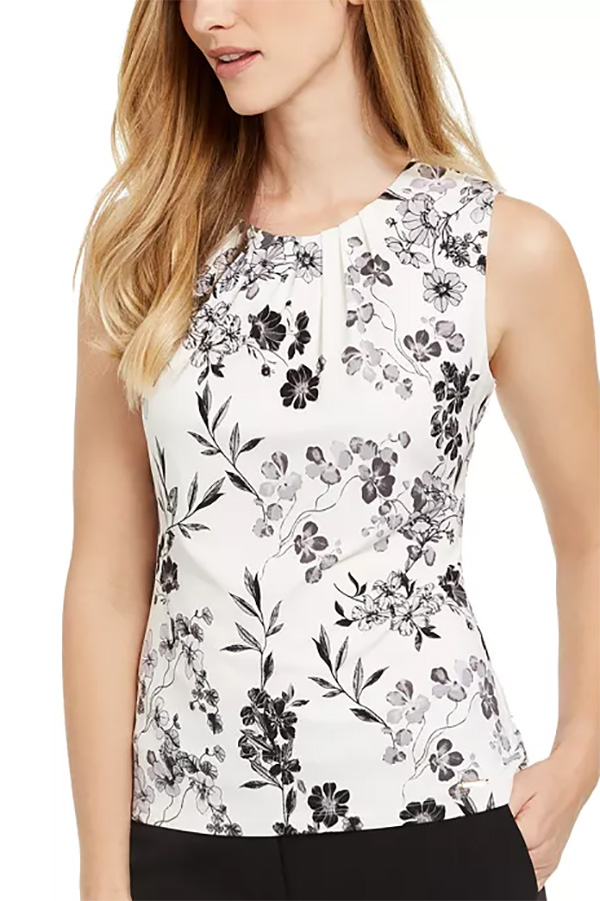
Good candidates for crossover pieces are blouses that pair with jeans as well as pencil skirts, ponte pants you can wear with a blazer or a t-shirt, and floral dresses that work with sneakers as well as kitten heels.
14. Impose a waiting period
If you make impulsive purchases, a waiting period will definitely save you money. Simply decide that you’ll wait 24 or 48 hours before transacting any clothing purchases over $10. After the time passes, you’ll probably feel less of an urge to buy that piece.
15. Unsubscribe
Others will tell you to subscribe to emails to save money on clothing. I disagree. My advice is the opposite: Unsubscribe from all fashion emails.
Here’s why. The emails encourage you to buy stuff you don’t need. They’re professionally designed for that purpose. That’s why you often get a discount upfront for subscribing. Because the marketing folks know that most people who subscribe will end up buying more in the long run.
Also, the upfront discount for subscribing is often available on coupon sites and in browser extensions. — no email address required.
16. Disconnect from the feeds
Fashion-related social media posts can function like marketing emails. The endless rotation of beautiful, stylish outfits can reinforce unhealthy attitudes about style — that you shouldn’t wear the same garment twice, for example, or that you can’t leave the house without being perfectly polished.
If the feeds are dialing up your urge to shop, disconnect. You don’t need to live up to the standards of someone else’s curated, filtered, and staged moments.
17. Get a new hobby
Boredom may be driving you to shop more than you should. In that case, take up a new (and cheap) hobby. Gardening, reading, writing, drawing, and running are options. Experiment with different activities until you find one that can naturally fill up your free moments.
18. Set guidelines
There’s a long-running joke in my household about $4 shorts. My husband, who is a true budget fashionisto, once bought a pair of $4 shorts off the clearance rack at Kohl’s. He wore them until they fell apart. Now and forever more, he compares all shorts purchases to that $4 price point. Ten bucks or $15 might be an acceptable stretch for the right pair, but $20? No way.
You can, and should, set guidelines for the prices you’re willing to pay. I know I can buy perfectly wearable $5 t-shirts at Target, for example — so would I buy a t-shirt for more than $5? Nope.
The more aggressive you set your price limits, the more you’ll search to find acceptable pieces. But that’s OK. Make it a challenge and have fun in the hunt.
19. Get trendy with your nails
Trends are terrible for your budget. You spend $50 on an asymmetrical top, wear it for one season, and then retire it in favor of the next big thing.
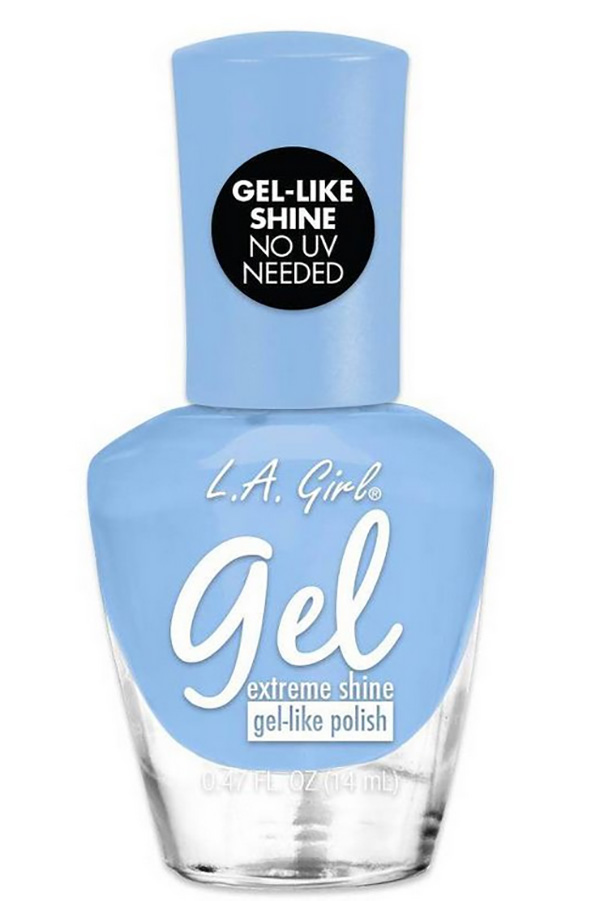
To keep your clothing spend lean, stick with classic, timeless garments. And participate in trends in the smallest ways. My favorite strategy here is nail polish. Head over to Pantone to see the season’s hottest colors, then spend $10 on two bottles of polish. That beats the $50 single-season top.
20. Know your return policies
Never buy a garment or pair of shoes without knowing the store’s return policy. Just don’t do it.
21. Clear auto fill, cookies on your browser
Those convenience features on your browser make it very easy to shop without thinking. If you’re going to shop online, you should at least have to find your credit card and input the numbers manually.
Locate the preferences area on your browser and clear all saved addresses and saved credit cards. While you’re at it, clear cookies too. That will log you out of Target.com and Amazon.
22. Delete shopping apps from your phone
Shopping apps send push notifications, which are as deadly to your budget as emails. The worst are push notifications about flash sales. These stoke FOMO, urging you to shop fast before the sale ends. The only time this works in your favor is if you’d previously decided to buy a piece and now the price is suddenly lower. Which happens almost never.
23. Don’t get too excited about sales
Most sales are over-rated. Too many times I’ve seen retailers mark prices up so they can mark them down again (I’m looking at you Old Navy). Don’t get caught up in the messaging.
24. Don’t shop without a list
Never shop without knowing what you need. An open-ended shopping excursion leads to the opening of your wallet, and not in a good way. Check your closet inventory, decide what exactly you need, and then shop.
You might change your mind along the way, and that’s OK. I do it all the time. When that happens, stay in a focused mindset. So: “I thought I wanted a tunic, but now a peplum top seems like a better idea.” Not: “I went shopping for a tunic and ended up with two pairs of jeans, some adorable sandals, and faux leather moto. But I still need a top…”
You can stop spending so much on clothes
You can save money on clothes by shopping with focus, buying timeless, versatile clothes you’ll actually wear, and (of course) taking advantage of coupons, rebates, and other discounts. This might take a mindset shift — but once you create these habits, you’ll be an empowered, and very stylish, shopper.



